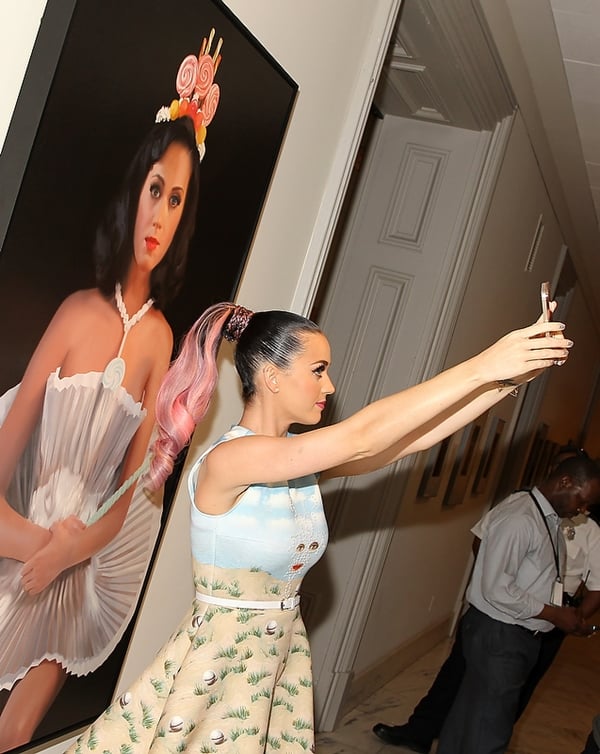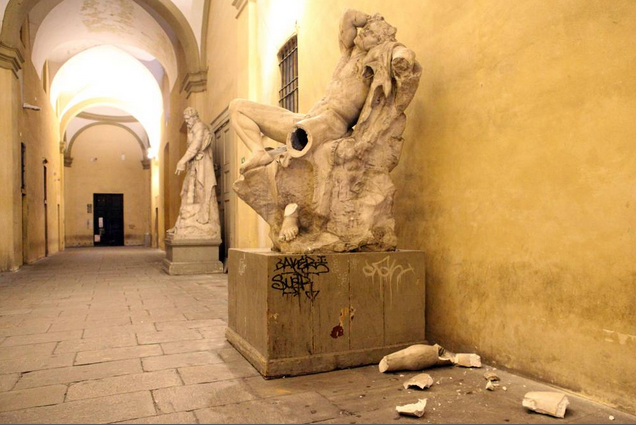Art & Exhibitions
Are Museum Selfies Endangered? Museums Ban Selfie Sticks
Sorry snap-happy museum patrons.

Photo: Paul Morigi/AP Images for National Portrait Gallery.
Sorry snap-happy museum patrons.

Sarah Cascone

As the world celebrated museum selfie day last month (see Did You Know It’s Museum Selfie Day?), some snap-happy museum patrons may have found themselves running afoul of the rules at a growing number of institutions that are banning selfie sticks.
Though artnet News may have only gotten wind of the selfie stick last summer (see Will Art Lovers Embrace the Selfie Stick?), the device appears to experiencing a surge of popularity, based on growing in-the-wild sightings and media coverage like NPR’s The Unstoppable Selfie Stick Trend Has Invaded American Shores. (Reports also indicate iStabilizer selfie sticks were a hot item this past holiday season, and that January sales were even better.) Many art museums, however, are not fans.
“I am pro-selfie, just not pro-selfie stick,” Sree Sreenivasan, the chief digital officer of New York’s Metropolitan Museum of Art, told Mashable. (artnet News was not aware that it was possible to have a political stand on selfies.) “I’m worried about visitor safety and protecting our art.”
Museums Who’ve Banned the Selfie Stick
The Met hasn’t yet imposed a selfie stick ban, but the museums that have include Boston’s Museum of Fine Arts; Dia: Beacon in Beacon, New York; and New York’s Museum of Modern Art and Cooper Hewitt, Smithsonian Design Museum. In Los Angeles, the J. Paul Getty Museum allows selfie sticks on the grounds, but not indoors, where they could damage art or injure patrons. Some museums, like MoMA, have tacked on selfie sticks to existing bans on camera extension devices such as tripods and monopods, while others, like the Guggenheim, New York, (and certain Marina Abramović shows—see Marina Abramović’s “No Selfies” Show Comes to Sean Kelly) don’t permit photography in general.
Art museum crowds can be tricky to navigate as it is, and one proposal would designate a daily selfie-free hour at all museums (see Should Museums Ban Selfies for an Hour Every Day?), claiming that constant picture-taking can detract from the museum experience.
Even without sticks, selfies have proven to be dangerous for works of art. Just last year, students in Italy and Germany made headlines with their art-selfies-gone-wrong, respectively smashing a 19th-century copy of an Ancient Greek statue (see Italian Student Smashes Sculpture While Taking Selfie) and getting stuck inside a monolithic vagina sculpture (see 32-Ton Marble Vagina Traps US Exchange Student). Visitors to Kara Walker’s A Subtlety or the Marvelous Sugar Baby in Brooklyn may not have damaged the massive sugar sphinx, but a number of their selfies were in incredibly poor taste (see Kara Walker’s Sugar Sphinx Spawns Offensive Instagram Photos).

At Milan’s Academy of Fine Arts of Brera, a nineteenth-century copy of the ancient Greek statue, the Drunken Satyr, was the victim of a vicious selfie attack.
Photo: Nicola Vaglia, courtesy Corriere della Sera.
Nonetheless, selfies, even when they aren’t taken in front of great masterpieces, are increasingly being considered works of art. Bloomsbury Auctions is currently offering a historic “space selfie” taken by Buzz Aldrin during Apollo 11 (see First Ever ‘Space Selfie’ by Buzz Aldrin Heads to Bloomsbury Auctions), Pakistani artists have made Hijab selfies a movement (see Pakistani Artists Take #DamnILookGood Hijab Selfies), and there’s actually a college course aimed at mastering the art (see London College Offers Selfie Course). Even art publishing house Rizzoli is releasing Selfish, a book of Kim Kardashian selfies the reality star is calling “intimate and artistic,” despite a predictably unsubtle cover featuring a near-indecent amount of cleavage (see Kim Kardashian’s Selfies Oddly Legitimized by Art Publisher).
Selfies and Art
In a related vein, famous artworks have also been recast as selfies (see Old Master Portraits Star in the Lastest Art Selfie Trend and “Statue Selfies” Are the Next Great Internet Art Trend), and a Swiss ad campaign imagined famous artists turning the camera on themselves (see Funny Ads Feature Van Gogh and Frida Kahlo Taking Selfies). Contemporary celebrities have also been spotted embracing the trend (see Beyoncé and Jay Z Elevate the Art Selfie Into a Movement, Katy Perry Takes Selfie with Will Cotton’s Portrait of Her at the NPG, and Katy Perry Takes Selfie with American Gothic), and “Shelfies” from the London Art Book included self-taken portraits from artists such as Antony Gormley (see Tracey Emin and Damien Hirst Share “Shelfies”).
Other innovations in selfie technology, such as the smartphone device that lets you trigger selfies from far away (see Take Selfies Remotely With New Smartphone Remote), or the rear facing selfie flash from Lenovo that enables low-light shots, appear to be safe for now—although many museums do have blanket bans on flash photography, selfie or otherwise. Should MoMA consider placing a selfie stand (see Japan Installs Selfie Stands at Popular Photo Op Sites) in front of Vincent van Gogh’s Starry Night?
It may be practical to ban selfie sticks now, but will it remain so, as selfies become more and more prevalent in our modern culture? It is easy to imagine a day in which all smart phones come with built in extension devices, enabling all of us to capture that perfect snapshot in front of any great work of art. Do museums really want to stand in the way of such social media-ready moments?